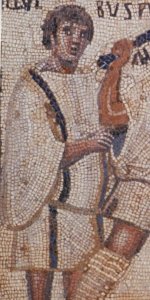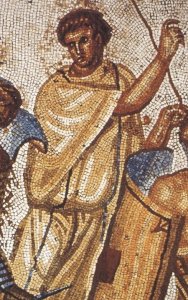How to build the roman military tunic
Today there is nothing in modern clothing that is similar to the tunic. The tunic was the least common denominator for every man in ancient times and could take on the most varied features, from underwear to a daily dress or even to be used as a nightgown.
The Romans distinguished clothes that could be brought in contact with the body, in other words those "internal" (indictus), from those that could be exhibited like the toga (amictus). The tunic is certainly part of the first group, although it could be worn at sight.
A detail is important: the presence or not of a cingulum (belt), that could be done in fabric, for example a hemp rope, either leather as in modern belts. The presence of a cingulum made the dignity (pro-cinctus) tunic and thus portable outside the home walls otherwise the scandal could be scattered (dis-cintus).
In military terms the balteus assumed the same meaning as cingulum (term with more civil sense). It was, in fact, a slight punishment for a soldier being on guard duty without the balteus.
The reasons why this was a punishment are only conceivable. Observing that the non-balteus tunic tends to slide down below the knee, we can easily argue the reason for the punishment: the long tunic was intended for women, so a tunic without balteus gave a feminine and not virile impression.
We also know that by dressing only a simple tunic, even if it was lined, was a low class indicator style. The richest classes wore over tunic other clothes such as the toga, including the one in use, for example, within the senatorial class members.
Nowadays, some of these clothes in the late empire fashion, though with some historical influence due to Jewish origins, form the sacred vestments of the Catholic Church, which is by no chance called also "Roman"-Catholic.
|
|
Even white, just as color, was an pretty expensive product derived from sulfur and urea processing, so it could has been a privilege of the notables and higher status people. A circumstance to consider, as example, is that wearing white dresses a prestige index. Soldiers could be allowed to triumph in Rome wearing white tunicas in exceptional cases and in other cases white was the "color" of so-called "candidates" terms that is sometimes used to refer to the Praetorian Guard when acting as Emperor bodyguards.
Materials
There are many evidences of the materials used. All of the at the time known textile materials were used: linen and wool above all, but also hemp. There is currently no evidence of the use of expensive silk or of the cotton, which, was well known by the Greeks, and presumably because of its difficulty in spinning, became common only in the Industrial Age. The latter two materials should be avoided in the reconstructions as any kind of acrylic fiber.
The classic or rectangular shape
The most elementary and probably the most classic form until the late period was that of a simple rectangle featuring three holes: two for the arms and one for the head, making sure that the abundance of the cloth covers a large part of the arm but not reaches the forearm, avoiding difficult moving.
Such a tunic could be embellished by a detail, that is, that it was realized in a single piece of cloth and not with two different rectangles sewn together possibly even reused2.
To get the correct length, once worn, check that "without wearing the balteus" the tunic gets well below (3-5 cm) of the knee. In fact, once the balteus will be enclosed, it will be possible to remove some of the fabric from above to let it fall back to hide the belt.
In this way, adjust the tunic so that its length reaches well above the knee.
You will then get the welcome effect that if you need to bend, the tunic will not rise further revealing the intimate parts.
In the imperial age the length under the knee determined whether the tunic was a feminine or effeminate garment, or anyway ridiculous3.
|
|

Fig. 5 - The classic Tunic with colour purple clavii.
| The main defect in the "T" shape (next paragraph) is the reduction of leg movements freedom. In fact, the tunic is narrow and it is impossible to enlarge the legs to the maximum extent. This causes many annoyances during any physical exercise, especially while fighting. Using the classic tunic, the problem is absent, but it may happen that you find a slight bump while working because the arms are surrounded by excess of fabric. To make up for this inconvenience during manual working, the Romans picked up the cloth over the neck creating a fabric ball that probably stopped with a lace (fig. 6). |
|
 Fig.7 - Example of a classic tunic from a III cent. AD (Prado Museum, Madrid) |
 Fig.8 - Example of a classic tunic wore from a lanista. II-III cent. AD, Galleria Borghese, Rome. |
The Clavii
The Romans had a great deal to their style of dress that was often ostentation of their social or economic status, much more so than today.
One of the ways to highlight its wealth was to use colored clothing because the color was certainly expensive. Even the color purple was so expensive to achieve in our times as characteristic of only emperors or a few of the highest institutional offices.
Notes
(1) Roman Military Clothing vol.1 (2002) - Graham Sumner, Osprey
Roman Militay Dress ) - Graham Sumner (2009), History Press
(2) Gospel of John (19,23-24)
(3) Virgil - Aeneid IX, 615.
(4) Talking about the Pretorian Guard must be argued that most of the officers were members of the most influent (rich) families in Rome.
(5) SHA, Claudius, XVII, 6.
(C) 1996-2025 Luca Bonacina









